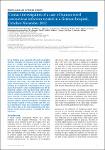Contact investigation of a case of human novel coronavirus infection treated in a German hospital, October-November 2012
Buchholz, Udo
Müller, Marcel A.
Nitsche, Andreas
Sanewski, A.
Wevering, N.
Bauer-Balci, T.
Bonin, F.
Drosten, Christian
Schweiger, Brunhilde
Wolff, Thorsten
Muth, D.
Meyer, B.
Buda, Silke
Krause, Gérard
Schaade, Lars
Haas, Walter
On 24 October 2012, a patient with acute respiratory distress syndrome of unknown origin and symptom onset on 5 October was transferred from Qatar to a specialist lung clinic in Germany. Late diagnosis on 20 November of an infection with the novel Coronavirus (NCoV) resulted in potential exposure of a considerable number of healthcare workers. Using a questionnaire we asked 123 identified contacts (120 hospital and three out-of-hospital contacts) about exposure to the patient. Eighty-five contacts provided blood for a serological test using a two-stage approach with an initial immunofluorescence assay as screening test, followed by recombinant immunofluorescence assays and a NCoV-specific serum neutralisation test. Of 123 identified contacts nine had performed aerosol-generating procedures within the third or fourth week of illness, using personal protective equipment rarely or never, and two of these developed acute respiratory illness. Serology was negative for all nine. Further 76 hospital contacts also tested negative, including two sera initially reactive in the screening test. The contact investigation ruled out transmission to contacts after illness day 20. Our two-stage approach for serological testing may be used as a template for similar situations.
Dateien zu dieser Publikation
Keine Lizenzangabe

